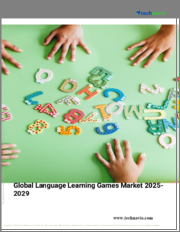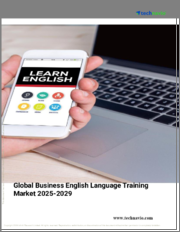
|
시장보고서
상품코드
1518427
언어 학습 앱 시장 : 제공별, 학습 모드별, 연령대별, 언어별, 최종사용자별, 지역별 - 세계 예측(-2030년)Language Learning Apps Market by Offering, Learning Mode (One-on-one, Group), Age Group, Language, End User (Individual Learners, Educational Institutes, Government Bodies, Corporate Learners), and Geography - Global Forecast to 2030 |
||||||
"언어 학습 앱 시장 규모, 점유율, 예측 및 동향 분석 : 제공, 학습 모드, 연령대, 언어, 최종사용자, 지역별 - 2031년까지 세계 예측"이라는 제목의 이 보고서는 주요 5개 지역의 언어 학습 앱 시장을 상세히 분석하여 현재 시장 동향, 시장 규모, 시장 점유율, 최근 동향, 2031년까지의 예측에 중점을 두고 있습니다.
언어 학습 앱 시장은 2024년부터 2031년까지 21.9%의 CAGR로 2031년까지 319억 달러에 달할 것으로 예상됩니다. e러닝 시장 확대, 세계화, 국경 간 커뮤니케이션의 필요성 증가, 언어 학습 앱의 최소 비용 등이 시장 성장을 견인하고 있습니다. 그러나 단일 플랫폼의 포괄성 부족은 이 시장의 성장을 저해하는 요인으로 작용할 수 있습니다.
교육 부문에 대한 지출 증가, 인터넷 및 모바일 사용자 증가, 다국적 기업의 다국어 직원 선호도 증가는 시장 성장의 기회를 창출할 것으로 예상됩니다. 그러나 언어 학습 교재 및 프로그램의 품질과 효과성을 보장해야 하는 필요성과 제한된 초고속 인터넷 접근성은 이 시장에 진출하는 기업들에게 큰 도전이 될 것으로 보입니다. 또한, 인공지능(AI)과 로봇 기술의 통합은 세계 언어 학습 앱 시장의 주요 트렌드입니다.
목차
제1장 소개
제2장 조사 방법
- 조사 가정
- 연구의 한계
제3장 주요 요약
- 시장 개요
- 시장 분석 : 제공별
- 시장 분석 : 학습 모드별
- 시장 분석 : 연령층별
- 시장 분석 : 최종사용자별
- 시장 분석 : 지역별
- 경쟁 분석
제4장 시장 인사이트
- 개요
- 시장 성장에 영향을 미치는 요인
- 성장 촉진요인
- 세계화와 국경을 넘은 커뮤니케이션 요구 상승
- E-Learning 시장 성장
- 어학 학습 앱 최소 비용
- 성장 억제요인
- 단일 플랫폼에서의 포괄성의 결여
- 기회
- 교육 부문에 대한 지출 증가
- 인터넷과 휴대폰 사용자 증가
- 다국적 기업에 의한 다언어 직원에 대한 기호 상승
- 과제
- 어학 학습 교재나 프로그램 질과 효과를 보증할 필요성 상승
- 고속 인터넷이나 스마트 디바이스에 대한 접근성 제한
- 동향
- 인공지능과 로봇 기술의 통합
- 성장 촉진요인
- 밸류체인 분석
제5장 언어 학습 앱 세계 시장 : 제공별
- 개요
- 온라인 코스와 앱
- 개별지도
- SaaS(Software-as-a-Service)
제6장 어학 학습 앱 세계 시장 : 학습 모드별
- 개요
- 맨투맨 학습
- 그룹 학습
제7장 언어 학습 앱 세계 시장 : 연령층별
- 개요
- 17세 이하
- 17-20세
- 21-30세
- 31-40세
- 40세 이상
제8장 언어 학습 앱 세계 시장 : 언어별
- 개요
- 영어
- 프랑스어
- 스페인어
- 만다린
- 독일어
- 이탈리아어
- 아랍어
- 일본어
- 한국어
- 기타 언어
제9장 언어 학습 앱 세계 시장 : 최종사용자별
- 개요
- 개인 학습자
- 교육기관
- K-12
- 고등교육기관
- 정부기관
- 기업 학습자
제10장 언어 학습 앱 시장 : 지역별
- 개요
- 북미
- 미국
- 캐나다
- 유럽
- 독일
- 영국
- 프랑스
- 이탈리아
- 스페인
- 러시아
- 폴란드
- 네덜란드
- 벨기에
- 스웨덴
- 오스트리아
- 스위스
- 핀란드
- 노르웨이
- 터키
- 아일랜드
- 룩셈부르크
- 기타 유럽
- 아시아태평양
- 일본
- 중국
- 인도
- 한국
- 싱가포르
- 말레이시아
- 호주·뉴질랜드
- 인도네시아
- 베트남
- 대만
- 홍콩
- 기타 아시아태평양
- 라틴아메리카
- 멕시코
- 브라질
- 기타 라틴아메리카
- 중동 및 아프리카
- 사우디아라비아
- 아랍에미리트
- 기타 중동 및 아프리카
제11장 경쟁 분석
- 개요
- 주요 성장 전략
- 경쟁 벤치마킹
- 경쟁 대시보드
- 업계 리더
- 시장 차별화 요인
- 선행 기업
- 신흥 기업
- 시장 점유율/주요 순위 분석(2022년)
제12장 기업 개요(기업 개요, 재무 개요, 제품 포트폴리오, 전략적 전개)
- Duolingo Inc.(미국)
- Memrise Inc.(영국)
- Busuu Ltd(영국)
- Berlitz Corporation(미국)
- Mango Languages(미국)
- Pimsleur(미국)
- Rosetta Stone, Inc.(미국)
- HelloTalk(홍콩)
- Inlingua International Ltd.(프랑스)
- Lesson Nine GmbH(Babble)(독일)
- PlanB Labs OU(Drops)(에스토니아)
- Transparent Language, Inc.(미국)
- Open Education LLC(미국)
- Linguistica 360, Inc.(미국)
- Mondly(Romania)
- FluentU(A part of Enux Education Limited)(미국)
- Lingvist Technologies OU(에스토니아)
- Beelinguapp UG(독일)
- ELSA Corp.(미국)
- FALOU APP(브라질)
- Lang-8 Inc.(HiNative)(일본)
- Tripod Technology GmbH(Tandem)(독일)
- Lingualift(영국)
(참고 : 상위 5개사 SWOT 분석을 제공 예정)
제13장 부록
ksm 24.07.31Language Learning Apps Market Size, Share, Forecast, & Trends Analysis by Offering, Learning Mode (One-on-one, Group), Age Group, Language, End User (Individual, Educational, Government, Corporate), and Geography-Global Forecast to 2031.
The research report titled 'Language Learning Apps Market Size, Share, Forecast, & Trends Analysis by Offering, Learning Mode (One-on-one, Group), Age Group, Language, End User (Individual, Educational, Government, Corporate), and Geography-Global Forecast to 2031', provides in-depth analysis of the language-learning apps market across five major geographies and emphasizes on the current market trends, market sizes, market shares, recent developments, and forecasts till 2031.
The language-learning apps market is projected to reach $31.9 billion by 2031, at a CAGR of 21.9% from 2024-2031. The growing e-learning market, globalization, the growing need for cross-border communication, and the minimal cost of language-learning apps drive the growth of this market. However, a lack of comprehensiveness in a single platform may restrain the growth of this market.
The increased spending on the education sector, rising internet & mobile phone user base, and growing preferences for multilingual employees by multinational companies are expected to create market growth opportunities. However, the need to ensure the quality & effectiveness of language-learning materials & programs and limited access to high-speed internet is a major challenge for the players operating in this market. Additionally, the integration of artificial intelligence (AI) & robot technology is a major trend in the global language-learning apps market.
The global language-learning apps market is segmented based on offering, learning mode, age group, and end user. This study also evaluates industry competitors and analyses the market at the country level.
Based on offering, the global language-learning apps market is segmented into online courses & apps, tutoring, and software as a service (SaaS). In 2024, the online courses & apps segment is estimated to account for the larger share of the language-learning apps market. The growth of this segment is driven by the growing need for certificates & credentials recognized by institutions, the increasing need to access educational content from anywhere, the need for cost-effective, diverse course offerings, and increasing government support for online education initiatives & investments in digital infrastructure. Further, the tutoring segment is projected to register the highest CAGR during the forecast.
Based on learning mode, the language-learning apps market is segmented into one-on-one learning and group learning. In 2024, the one-on-one learning segment is estimated to account for a larger share of the language-learning apps market. The growth of this segment is driven by globalization and interconnectedness, the need for highly personalized experiences tailored to the individual learner's pace, the increasing need for more cost-effective alternatives to traditional language schools or immersion programs, growing focus on specific learning objectives, rising demand for job opportunities, growing need for continuous self-improvement and skill development are driving the growth of this segment. Further, the group learning segment is estimated to register the highest CAGR during the forecast period.
Based on age group, the language-learning apps market is segmented into <18 years, 18-20 years, 21-30 years, 31-40 years, and >40 years. In 2024, the <18 years segment is expected to account for the largest share of the language-learning apps market. The digitization of public schools, an increasing number of language learners, significant growth in smartphone users, rising demand for kids' learning apps, the popularity of online interactive games for language learning, and the growing e-learning platforms are expected to drive the segment growth in the coming years. Further, the 18-20 years segment is projected to register the highest CAGR during the forecast period.
Based on language, the language-learning apps market is broadly segmented into English, French, Spanish, Mandarin, German, Italian, Arabic, Japanese, Korean, and other languages. In 2024, the English language segment is expected to account for the largest share of the language-learning apps market. The large market share of this segment is attributed to the growing number of English language learners worldwide, the increasing emphasis on learning English in schools & educational institutions, the growing priority for English in business & professional areas, and rising investments in start-ups & small companies teaching English. Further, the Mandarin language segment is poised to register the highest CAGR during the forecast period.
Based on end user, the language-learning apps market is segmented into individual learners, educational institutes, government bodies, and corporate learners. In 2024, the individual learners segment is estimated to account for the largest share of the language-learning apps market. This segment's growth is driven by the rising adoption of smart devices coupled with faster internet penetration, the increasing need for transmission of live content on the internet for better brand engagement and student reach, the rising adoption of self-learning apps, the surging social media platforms, and the high number of free language-learning apps. Further, the individual learners segment is projected to register the highest CAGR during the forecast period.
Based on geography, the language-learning apps market is segmented into North America, Asia-Pacific, Europe, Latin America, and the Middle East & Africa. In 2024, Asia-Pacific is estimated to account for the largest share and highest CAGR of the language-learning apps market. This region's large market share is attributed to the growing need to improve communication across borders, high demand for multilingual professionals, rising adoption of self-learning apps in corporate training programs & language institutes, increasing digitalization of educational content government initiatives to strengthen national education networks, increasing demand for flexible & convenient language-learning options, and for online cost-effective programs that address the knowledge gap in students. Moreover, the Asia-Pacific region is also projected to register the highest CAGR during the forecast period.
Key Players:
The key players operating in the language-learning apps market are Duolingo Inc. (U.S.), Memrise Inc. (U.K.), Busuu Ltd (U.K.), Berlitz Corporation (U.S.), Mango Languages (U.S.), Pimsleur (U.S.), Rosetta Stone, Inc. (U.S.), HelloTalk (China), Inlingua International Ltd. (France), Lesson Nine GmbH (Babble) (Germany), PlanB Labs OU (Drops) (Estonia), Transparent Language, Inc. (U.S.), Open Education LLC (U.S.), Linguistica 360, Inc. (U.S.), Mondly (Romania), FluentU (A part of Enux Education Limited) (U.S.), Lingvist Technologies OU (Estonia), Beelinguapp UG (Germany), ELSA Corp. (U.S.), FALOU APP (Brazil), Lang-8 Inc. (HiNative) (Japan), Tripod Technology GmbH (Tandem) (Germany), and Lingualift (U.K.).
Key questions answered in the report-
- Which are the high-growth market segments based on offering, learning mode, age group, end user, and geography?
- What was the historical market for the language-learning apps market?
- What are the market forecasts and estimates for the period 2024-2031?
- What are the major drivers, restraints, opportunities, and challenges in the language-learning apps market?
- Who are the major players, and what shares do they hold in the language-learning apps market?
- What is the competitive landscape like in the language-learning apps market?
- What are the recent developments in the language-learning apps market?
- What are the different strategies adopted by the major players in the language-learning apps market?
- What are the key geographic trends, and which are the high-growth countries?
- Who are the local emerging players in the language-learning apps market, and how do they compete with the other players?
Scope of the report:
Language-learning Apps Market Assessment-by Offering
- Online Courses and Apps
- Tutoring
- Software as a Service (SaaS)
Language-learning Apps Market Assessment-by Learning Mode
- One-on-One Learning
- Group Learning
Language-learning Apps Market Assessment-by Age Group
- <18 Years
- 18-20 years
- 21-30 years
- 31-40 years
- >40 years
Language-learning Apps Market Assessment-by Language
- English
- French
- Spanish
- Mandarin
- German
- Italian
- Arabic
- Japanese
- Korean
- Other Languages
Language-learning Apps Market Assessment-by End User
- Individual Learners
- Educational Institutes
- K-12
- Higher Education
- Government Bodies
- Corporate Learners
Language-learning Apps Market Assessment-by Geography
- North America
- U.S.
- Canada
- Latin America
- Brazil
- Mexico
- Rest of Latin America
- Europe
- Germany
- U.K.
- France
- Italy
- Spain
- Russia
- Poland
- Netherlands
- Belgium
- Sweden
- Austria
- Switzerland
- Finland
- Norway
- Turkey
- Ireland
- Luxembourg
- Rest of Europe
- Asia-Pacific
- China
- Japan
- South Korea
- India
- Indonesia
- Australia & New Zealand
- Taiwan
- Hongkong
- Singapore
- Malaysia
- Vietnam
- Rest of Asia-Pacific
- Middle East & Africa
- UAE
- Saudi Arabia
- Rest of Middle East & Africa
TABLE OF CONTENTS
1. Introduction
- 1.1 Market Definition & Scope
- 1.2 Market Ecosystem
- 1.3 Currency & Limitations
- 1.4 Key Stakeholders
2. Research Methodology
- 2.1 Research Approach
- 2.2 Data Collection and Validation Process
- 2.2.1 Primary Research/Interviews with Key Opinion Leaders from the Industry
- 2.2.2 Secondary Research
- 2.3 Market Sizing and Forecast Approach
- 2.3.1 Market Estimation Approach
- 2.3.1.1 Bottom-up Approach
- 2.3.1.2 Top-down Approach
- 2.3.1.3 Growth Forecast Approach
- 2.3.2 Market Share Analysis
- 2.3.1 Market Estimation Approach
- 2.4 Assumption for the Study
- 2.5 Limitations for the Study
3. Executive Summary
- 3.1 Market Overview
- 3.2 Market Analysis, by Offering
- 3.3 Market Analysis, by Learning Mode
- 3.4 Market Analysis, by Age Group
- 3.5 Market Analysis, by End User
- 3.6 Market Analysis, by Geography
- 3.7 Competitive Analysis
4. Market Insights
- 4.1 Overview
- 4.2 Factors Affecting Market Growth
- 4.2.1 Drivers
- 4.2.1.1 Globalization and the Growing Need for Cross-Border Communication
- 4.2.1.2 Growing E-Learning Market
- 4.2.1.3 Minimal Cost of Language Learning Apps Applications
- 4.2.2 Restraints
- 4.2.2.1 Lack of Comprehensiveness in a Single Platform
- 4.2.3 Opportunities
- 4.2.3.1 Increasing Spending on the Education Sector
- 4.2.3.2 Rising Internet and Mobile Phone User Base
- 4.2.3.3 Growing Preferences for Multilingual Employees by Multinational Companies
- 4.2.4 Challenges
- 4.2.4.1 Increasing Need to Ensure the Quality and Effectiveness of Language Learning Materials And Programs
- 4.2.4.2 Limited Access to High-Speed Internet or Smart Devices
- 4.2.5 Trends
- 4.2.5.1 Integration of Artificial Intelligence & Robot Technology
- 4.2.1 Drivers
- 4.3 Value Chain Analysis
5. Global Language Learning Apps Market, by Offering
- 5.1 Overview
- 5.2 Online Courses and Apps
- 5.3 Tutoring
- 5.4 Software as a Service (SaaS)
6. Global Language Learning Apps Market, by Learning Mode
- 6.1 Overview
- 6.2 One-on-One Learning
- 6.3 Group Learning
7. Global Language Learning Apps Market, by Age Group
- 7.1 Overview
- 7.2 <17 years
- 7.3 17-20 years
- 7.4 21-30 years
- 7.5 31-40 years
- 7.6 >40 years
8. Global Language Learning Apps Market, by Language
- 8.1 Overview
- 8.2 English
- 8.3 French
- 8.4 Spanish
- 8.5 Mandarin
- 8.6 German
- 8.7 Italian
- 8.8 Arabic
- 8.9 Japanese
- 8.10 Korean
- 8.11 Other Languages
9. Global Language Learning Apps Market, by End User
- 9.1 Overview
- 9.2 Individual Learners
- 9.3 Educational Institutions
- 9.3.1 K-12
- 9.3.2 Higher Education
- 9.4 Government Institutes
- 9.5 Corporate Learners
10. Language Learning Apps Market, by Geography
- 10.1 Overview
- 10.2 North America
- 10.2.1 U.S.
- 10.2.2 Canada
- 10.3 Europe
- 10.3.1 Germany
- 10.3.2 U.K.
- 10.3.3 France
- 10.3.4 Italy
- 10.3.5 Spain
- 10.3.6 Russia
- 10.3.7 Poland
- 10.3.8 Netherlands
- 10.3.9 Belgium
- 10.3.10 Sweden
- 10.3.11 Austria
- 10.3.12 Switzerland
- 10.3.13 Finland
- 10.3.14 Norway
- 10.3.15 Turkey
- 10.3.16 Ireland
- 10.3.17 Luxembourg
- 10.3.18 Rest of Europe
- 10.4 Asia-Pacific
- 10.4.1 Japan
- 10.4.2 China
- 10.4.3 India
- 10.4.4 South Korea
- 10.4.5 Singapore
- 10.4.6 Malaysia
- 10.4.7 Australia & New Zealand
- 10.4.8 Indonesia
- 10.4.9 Vietnam
- 10.4.10 Taiwan
- 10.4.11 Hongkong
- 10.4.12 Rest of Asia-Pacific
- 10.5 Latin America
- 10.5.1 Mexico
- 10.5.2 Brazil
- 10.5.3 Rest of Latin America
- 10.6 Middle East & Africa
- 10.6.1 Saudi Arabia
- 10.6.2 UAE
- 10.6.3 Rest of Middle East & Africa
11. Competiton Analysis
- 11.1 Overview
- 11.2 Key Growth Strategies
- 11.3 Competitive Benchmarking
- 11.4 Competitive Dashboard
- 11.4.1 Industry Leaders
- 11.4.2 Market Differentiators
- 11.4.3 Vanguards
- 11.4.4 Emerging Companies
- 11.5 Market Share/Key Ranking Analysis (2022)
12. Company Profiles (Company Overview, Financial Overview, Product Portfolio, and Strategic Developments)
- 12.1 Duolingo Inc. (U.S.)
- 12.2 Memrise Inc. (U.K.)
- 12.3 Busuu Ltd (U.K.)
- 12.4 Berlitz Corporation (U.S.)
- 12.5 Mango Languages (U.S.)
- 12.6 Pimsleur (U.S.)
- 12.7 Rosetta Stone, Inc. (U.S.)
- 12.8 HelloTalk (Hong Kong)
- 12.9 Inlingua International Ltd. (France)
- 12.10 Lesson Nine GmbH (Babble) (Germany)
- 12.11 PlanB Labs OU (Drops) (Estonia)
- 12.12 Transparent Language, Inc. (U.S.)
- 12.12 Open Education LLC (U.S.)
- 12.14 Linguistica 360, Inc. (U.S.)
- 12.15 Mondly (Romania)
- 12.16 FluentU (A part of Enux Education Limited) (U.S.)
- 12.17 Lingvist Technologies OU (Estonia)
- 12.18 Beelinguapp UG (Germany)
- 12.19 ELSA Corp. (U.S.)
- 12.20 FALOU APP (Brazil)
- 12.21 Lang-8 Inc. (HiNative) (Japan)
- 12.22 Tripod Technology GmbH (Tandem) (Germany)
- 12.23 Lingualift (U.K.)
(Note: SWOT Analysis for the Top 5 Companies Will Be Provided)
13. Appendix
- 13.1 Available Customization
- 13.2 Related Reports



















